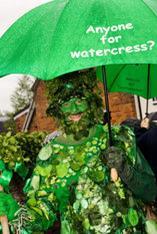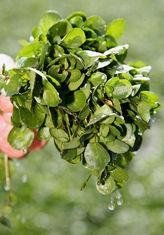

Although the good weather did not hold out for the annual Watercress Festival, which once again took place in the UK’s capital of watercress farming, families and trade alike still flocked to the parade, food awards and 45 stalls selling locally grown speciality foods at the Hampshire Fare Market. More than 8,000 people attended.
Organised by the Watercress Alliance, a body of British growers made up of the three largest producers in the UK - Bakkavor (formally Geest), Vitacress and the Watercress Company - to promote the taste and health benefits of watercress, the fun-packed day included an appearance from Alresford’s Watercress Man, a magical riverbed creature, and farm tours to find out more about the production of watercress. Also back by popular demand was celebrity chef Antony Worrall Thompson, who was holding open-air cookery demonstrations throughout the day - still attracting a crowd of about 250 in the rainy conditions - and who created three celebratory watercress dishes in honour of National Watercress Week.
The Watercress Alliance was formed four years ago to drive the watercress market forward, and the festival and awareness week has been part of this pro-active venture. “The market has seen a massive turnaround in sales since we formed, and not just in Watercress Week,” says Kip Winter-Cox, head of produce marketing at Bakkavor Ltd, which packs and markets produce grown by The Watercress Company. “In March 2003, sales were declining and since the alliance formed they have significantly increased. The important factor of the campaign is to produce year-round sales.”
Dr Steve Rothwell, production and technical director of Vitacress, which is part of the Watercress Alliance that farms, packs and distributes from 100 acres in Hampshire and Dorset, says that the demand for watercress generally increases due to National Watercress Week. “It did last year and we expect the same in 2007,” he tells FPJ. “The event is well promoted, and as a result our customers stock more and promote in store; so it’s a double impact.”
Tom Amery, supply and technical director of the Watercress Company, who spent most of last Sunday with a model watercress farm displayed on a barrow used over 60 years ago at Liverpool market, thoroughly enjoyed the day. “Even though the weather hasn’t been as good as last year, we still attracted the same amount of people,” he says. “Sales of watercress peaked after week seven this year following the anti-cancer press release, and are still holding up well.
“The key to Watercress Week, from a marketing point of view, is to give the supermarkets something to promote. Tesco, Somerfield and Asda are all running some in-store promotions, and Waitrose has featured watercress as one of its choice foods in its May magazine.”
According to market analyst TNS, the bagged salad market saw a volume sales increase of 2.6 per cent for the period 2005-06, and after a brief dip in sales due to the publication of Felicity Lawrence’s 2004 book Not on the Label, which criticised bagged salads as well as other foods, it looks like the industry is back on track. David Piccaver, chairman of the British Leafy Salads Association, has maintained that the book was based on “false information that was hyped up to make a good read whilst ignoring the facts”. And it seems as if the public has followed that opinion, albeit after a slight dip in sales.
The market for watercress stands at £3.3 million (TNS), and remains a favourite with consumers for its British origins and its peppery and distinct taste. According to Piccaver, watercress is becoming more and more popular and has recently experienced “a surge in demand”.
Further reason to get growing the superfood is that in February, the results of two years of research carried out by the University of Ulster showed that watercress has qualities that relate to the reduction of DNA damage of white blood cells, considered to be an important trigger in the development of cancer. “On average we have experienced a 40 per cent year-on-year growth,” says Amery. “Since the cancer research announcement, we have seen a 60 per cent growth in the last from week 10 to 13.”
Rothwell says that Vitacress has a good-quality crop this season and that yield has seen a five per cent increase on last year’s figures. “Overall, I estimate that about 120 tonnes of watercress is grown in the UK a week in the summer,” he says. “We grow about 50t a week in the UK and can pull in extra from [our crop in] Portugal over the summer to top up.”
One of the oldest leaf vegetables known to man, watercress can be traced back more than 3,000 years to the Persians and ancient Greece and is native to Europe and central Asia. Watercress has been grown commercially in the pure spring waters of southern England since the 1800s. The industry’s heyday was in the mid-1900s, with no less than 1,000 acres of watercress being grown in the UK. But due to problems such as railway cuts on the lines to London denying a route to market for many growers, and the impact of crook root disease, the acreage devoted to growing watercress in the UK now stands at fewer than 150 acres.
Vitacress started off as Hampshire Watercress with a Vitacress trademark. The business was founded by Malcolm Isaac in 1950 and changed its name to Vitacress in 1988. By the 1960s the watercress industry was failing, but the company was instrumental in turning this around. “Malcolm Isaac rekindled the industry with his move to packaging and getting it into the supermarkets in the early years,” says Rothwell. “Those who did not follow found their wholesale markets fell prey to the rapidly growing supermarket chains in the 1980s.”
Vitacress was the first to pack watercress in pillow packs for the supermarkets in the 1970s, which was one of the first bagged salads. And with change comes progress, with the company, like many others looking abroad to grow more produce. The fact it was revealed that this kind of produce was often washed in a chlorine solution of a greater concentration of a local swimming pool was another problem thrown at the watercress and indeed the bagged salad industry. “We were the first to guarantee year-round watercress by opening a farm in Portugal in 1982,” says Rothwell, who joined the company in 1983. “We were the first with organic watercress in the 1990s and took the washed and ready-to-eat watercress offer one step further by pioneering washing in pure spring water, with no chemicals, in 2006.”
Last year, the Watercress Company, which grows the product in three different countries (England, Spain and the US), produced more than two million kg of conventional watercress during 2006 and 300,000kg of organic watercress. Amery maintains that being the only watercress grower with farms in three different countries gives the Watercress Company an edge. “Everything is constantly being improved upon,” he says. “The work conducted over the last three years on production and quality is now proving very worthwhile.”
Vitacress is also working on maintaining its position in the market, growing its own seed in Portugal in summer and then seeding onto compost in its UK nursery using modular trays, which are grown in polytunnels. “We scatter tufts of seedlings to damp gravel beds, using a machine we designed and built. As crop roots into gravel we flow pure spring water over the beds. The plants take most nutrients they need from the water,” says Rothwell.
The company is also looking into a new breeding programme that it hopes will enhance the anti-cancer properties of watercress. “We will screen plants by exposing cultures of breast cancer cells to extracts,” Rothwell says of the three-year programme to start in October. “Having identified the most potent, we will look to identify the genes responsible for the expression of the active agents and then use molecular marking to guide a breeding programme based on our variety.”
The outlook for the watercress industry is not, however, altogether bright, with a tough fight on the hands of growers and packers to get a fair price. Selling more than 90 per cent of its produce to retail multiplies, Vitacress, says Rothwell, is not getting as good a price as it could. “I find it sad that the market is set on devaluing this superfood, which is produced in a very special way from finite resource of watercress beds,” he explains. “We know it is not price sensitive, yet retail today is at less per gram than 10 years ago.”
At the end of 2005, bagged salad sales were growing at seven per cent a year, and with the largest two sellers of the product being Tesco and Sainsbury’s, it is not hard to work out where the profit is going.
But Amery is not so worried. “The price of watercress in retail has been going down for some time, and this has been absorbed by retailers, growers and packers alike,” he says.
“While there is growth in the market, economies have applied, but we need to remember that watercress is not a commodity, and with a continuing demand for technical and quality standards, the current prices are unsustainable,” he adds.
“A good season is in prospect regarding quality and availability, but with deflating price and inflated costs,” predicts Rothwell. “Also, a failure of the planning system to recognise the value of watercress farms to the UK means the industry has problems ahead.”
However, it looks like the watercress industry will continue to flourish whatever comes its way, with the Watercress Alliance in full swing. “The industry has now got to focus on innovation, but also on its heritage,” says Winter-Cox. “Next year, we will celebrate the 200th year of commercial watercress growing in the UK and it is still grown very much the same way it was 200 years ago. We want consumers to appreciate this tradition.”
DID YOU KNOW THAT?
The herbalist John Gerard extolled watercress as an anti-scorbutic (remedy for scurvy) as early as 1636.
• One of Britain’s best-known dishes, watercress soup, became very popular in the 17th century when it was claimed to cleanse the blood.
• Victorians thought the plant was a cure for toothache, hiccups and even freckles.
• Watercress was promoted during the First World War as an important health-giving home-grown food.
• In the 1960s, the strongest demand for watercress came from the north, where whatever the family income, high tea reigned supreme.
THE WATERCRESS FESTIVAL
“The Watercress Festival has become one of the key food festivals in the country, which is a remarkable achievement in just four years,” said Wendy Akers, of Wendy Akers Public Relations, which created the event for The Watercress Alliance.
“People come from all over the country to go on farm tours, watch cookery demonstrations and learn more about the UK’s most historic salad leaf.
“Around 8,000 to 10,000 people attended Sunday’s event, which was amazing considering the weather was so bad. But rain doesn’t really seem out of place at a festival to celebrate watercress, so everybody took it in good spirits.”
“As well as being a great day out, the festival also achieves extensive media coverage, allowing watercress producers to get across their key messages of health, taste and versatility. It kicks off the start of National Watercress Week, which is now a regular fixture in the food calendar - we are already planning next year’s event.”